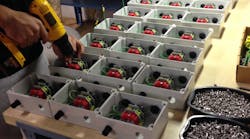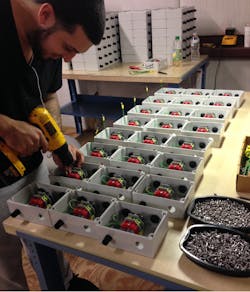The Build or Buy Decision: When to Outsource Electro-Mechanical Subassemblies
Given the world’s appetite for “smart” everything, today’s OEMs must increasingly incorporate electro-mechanical subassemblies into products. But stuffing these black boxes full of circuit cards, custom cables/wiring harnesses, and electro-mechanical elements like relays and servos may strain the resources of manufacturers that had produced primarily mechanical products.
At such a point, the manufacturer faces a critical “build-or-buy” decision: Do you deviate from your core competency and try to build the electronic assembly yourself, or is it wiser to outsource the work? This is a particularly crucial decision when the electronic components may only represent a small part of a larger product.
At present, the scales seemed to be tipping in favor of outsourcing the builds. According to statista.com, the global market for electronics contract manufacturing is projected to increase 54% over the five-year period spanning 2013 to 2018, eventually reaching an astounding $670 billion.
Such figures underscore the trend toward the outsourcing of subassemblies and the electronics and wiring within. Even some PC board manufacturers have found it more expedient and cost-effective to outsource some of their work to box-build specialists, rather than shoulder that extra work in-house.
“We have cable equipment here, and can do all of the box building ourselves,” says Jim Ayars, president of J&J Technologies, Inc., which provides turn-key and consignment electronic manufacturing services. “But for some production runs it doesn’t make sense to invest in the people, expertise, or equipment for making a particular cable, when we know we can get a fair price and good turnaround with a trusted subassembly partner. In this manner we can pass on the savings to the benefit of our customers.”
When DIY Doesn’t Make Sense
Many manufacturers still lay full claim to the creation and design of their products. They typically handle final assembly, along with most aspects of the systems engineering process. But when drilling down to the details of incorporating electrical and electronic subassemblies, and wiring it all together, many manufacturers can no longer justify shouldering the entire process in-house due to cost and scalability. This also holds true for OEMs that begin making their own electro-mechanical assemblies, only to discover that they cannot scale up quickly enough to keep up with production demands at higher volumes.
Given the obstacles of making every part themselves, many OEMs are instead simply purchasing the necessary subassemblies with the circuit cards and mechanical devices already inserted and wired together according to the manufacturer’s specifications—the so-called box build. “Every part you build up has specific tooling, so it’s a larger investment each time you want to do something new,” Ayars points out. “There’s a big benefit in utilizing someone that already has that equipment so you can keep your non-recurring costs to a minimum.
“Some manufacturers invest in advanced assembly technology—they purchase the machines and integrate them into their own business,” he continues. “But this technology is expensive and needs a certain level of volume to be sensible. At some point up the supply chain you have to stop and take advantage of what a specialized box builder does more economically and faster, and work out a partnership.”
When “time to market” ranks higher than “cost to produce,” the decision to outsource subassemblies makes even more sense. The rush to market a new product often precludes the time required to acquire the talent and infrastructure to match what subassembly contractors can do on short notice.
Further fueling the renewed acceptance of using subassemblers is the high level of quality coming out of U.S.-based companies. Process certifications such as ISO 9001, along with training standards like IPC/WHMA-A-620 (assembly) and J-STD-001 certification (soldering) help ensure a high standard of reliability. UL and CSA listings, along with RoHS manufacturing capabilities, help reduce liability for the parent company ordering the product. Working with onshore suppliers also enables quicker resolution of any issues.
The argument for buying built-to-spec boxes from subassembly houses has become so compelling that even some large contract manufacturers are opting to farm out the wire and the cable work. The profit margin is simply too low for them to justify doing it themselves. They, like so many OEMs, prefer to contract with a subassembly provider who can help them grow.
“It doesn’t matter if the box builder is large or small,” Ayars concludes. “For me, the ability to meet target production dates is most important…If another company has an expertise in wiring up cables that we don’t have, I’ll opt for that route every time.”
Skip Sullivan, President
Electro-Prep, Inc., 14 Kendrick Rd., Unit 3, Wareham, MA 02571; 800-478-4578, e-mail: info@electroprep.com, www.electroprep.com


